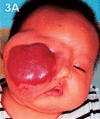Long term follow-up of intralesional laser photocoagulation (ILP) for hemangioma patients
- PMID: 24155535
- PMCID: PMC3799045
- DOI: 10.5978/islsm.11-or-03
Long term follow-up of intralesional laser photocoagulation (ILP) for hemangioma patients
Abstract
Background and objectives: Hemangiomas remain a challenge for patients and plastic surgeons. Promising results have been reported using intralesional photocoagulation (ILP) for treatment. The objective of our study is to review the long term results of a large series of hemangiomas in patients treated by ILP. Materials (Subjects) and Methods: A retrospective review of 684 hemangiomas in patients were treated by ILP with an Nd:YAG (neodymium-yttrium-aluminium-garnet) (1064 nm) laser over a period of 10 years (January 1996-January 2005). Patients' ages ranged from one month to 11 years 5 months (mean, 1 year 10 months). The patient group consisted of 474 females and 210 males.
Results: Patients were treated with an Nd:YAG laser delivered through a 600 m optical fiber. Laser power was set at 7 to 15 watts (W) and delivered with pulse duration of 7 to 15 seconds (s). The results showed 603 (88.6%) patients had more than 50% reduction of the volume in hemangiomas at 3 months after one treatment; and 663 (96.9%) patients had more than 50% reduction of the volume at 3 months after two treatments. Patients who had continuous ILP achieved excellent results.
Conclusions: Postoperative complications have been related to photocoagulation that has been delivered too extensively or superficially, with resultant ulceration, infection, bleeding, and scarring. These complications can be avoided if this potential for harm is kept in mind.
Keywords: Hemangioma; ILP; Nd:YAG Laser; Vascular malformation; intralesional photocoagulation.
Figures








Similar articles
-
Long Term Follow-up of Intralesional Laser Photocoagulation for Head and Neck Lymphatic Malformations Using Neodymium-Yttrium-Aluminium-Garnet Laser.Ann Plast Surg. 2020 Mar;84(3):288-292. doi: 10.1097/SAP.0000000000002049. Ann Plast Surg. 2020. PMID: 31800565
-
Intralesional photocoagulation of vascular anomalies of the tongue.Br J Plast Surg. 1999 Apr;52(3):178-81. doi: 10.1054/bjps.1998.3056. Br J Plast Surg. 1999. PMID: 10474467
-
Intralesional photocoagulation of periorbital hemangiomas.Plast Reconstr Surg. 1999 Jan;103(1):11-6; discussion 17-9. doi: 10.1097/00006534-199901000-00003. Plast Reconstr Surg. 1999. PMID: 9915158
-
Laser-Assisted Control of Epistaxis in Hereditary Hemorrhagic Telangiectasia: A Systematic Review.Lasers Surg Med. 2020 Apr;52(4):293-300. doi: 10.1002/lsm.23147. Epub 2019 Aug 22. Lasers Surg Med. 2020. PMID: 31441079 Free PMC article.
-
Cyclodestructive procedures for refractory glaucoma.Cochrane Database Syst Rev. 2019 Mar 10;3(3):CD012223. doi: 10.1002/14651858.CD012223.pub2. Cochrane Database Syst Rev. 2019. PMID: 30852841 Free PMC article.
References
-
- Mulliken JB, Glowacki J. (1982): Hemangiomas and vascular malformations in infants and children: A classification based on endothelial characteristics. Plast Reconstr Surg 69 (3): 412–422 - PubMed
-
- Bowers RE, Graham EA, and Tomlinson KM. (1960): The natural history of the strawberry nevus. Arch Dermatol 82: 667–680
-
- Zarem HA, Edgerton MT. (1967): Induced resolution of cavernous hemangiomas following prednisolone therapy. Plast Reconstr Surg 39 (1): 76–83 - PubMed
-
- Sasaki GH, Pang CY, Wittliff JL. (1984): Pathogenesis and treatment of infant skin strawberry hemangiomas: Clinical and in vitro studies of hormonal effects. Plast Reconstr Surg 73 (3): 359–370 - PubMed
-
- Kushner BJ. (1985): The treatment of periorbital infantile hemangiomas with intralesional corticosteroid. Plast Reconstr Surg 76 (4): 517–26 - PubMed
LinkOut - more resources
Full Text Sources
